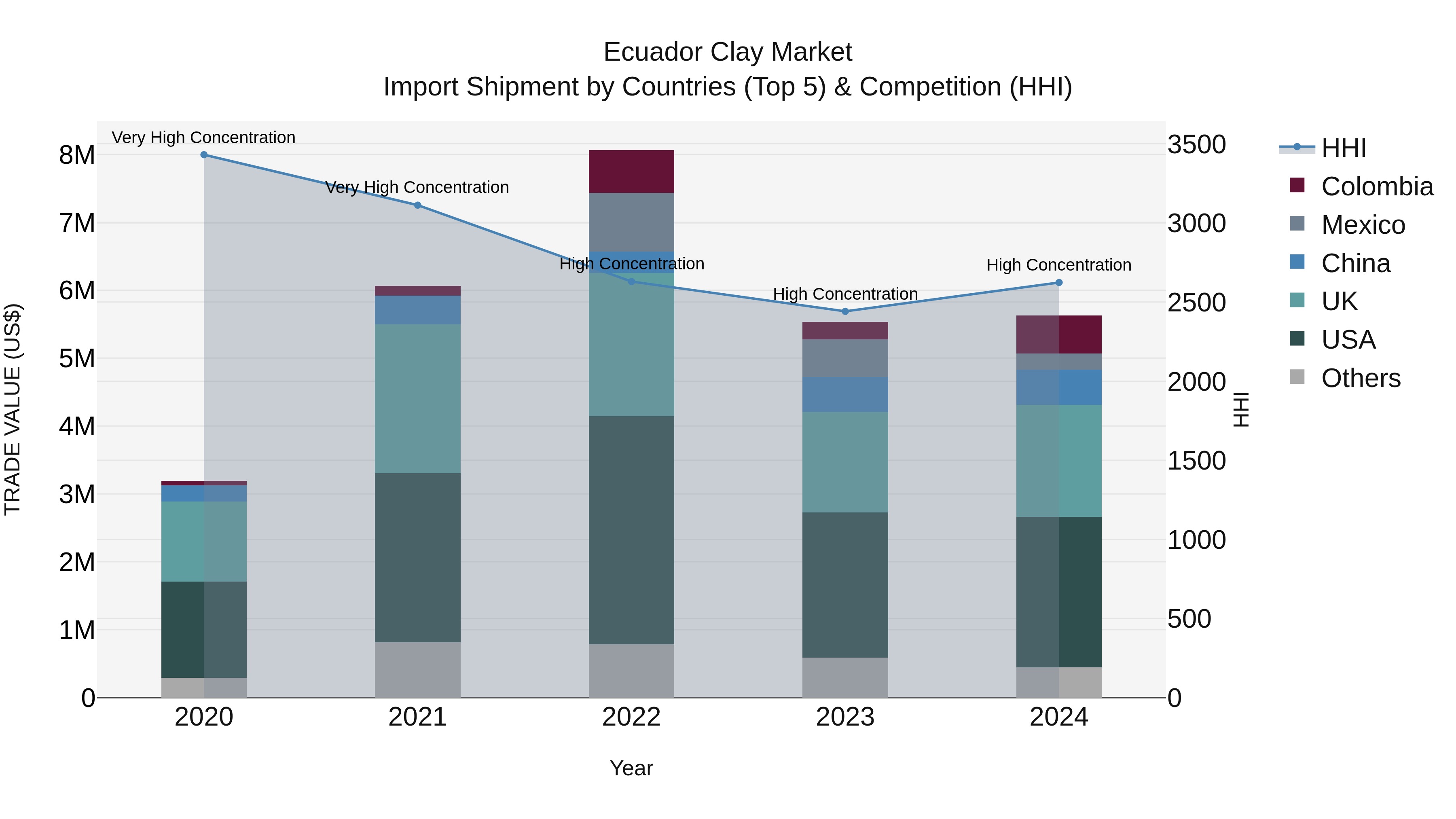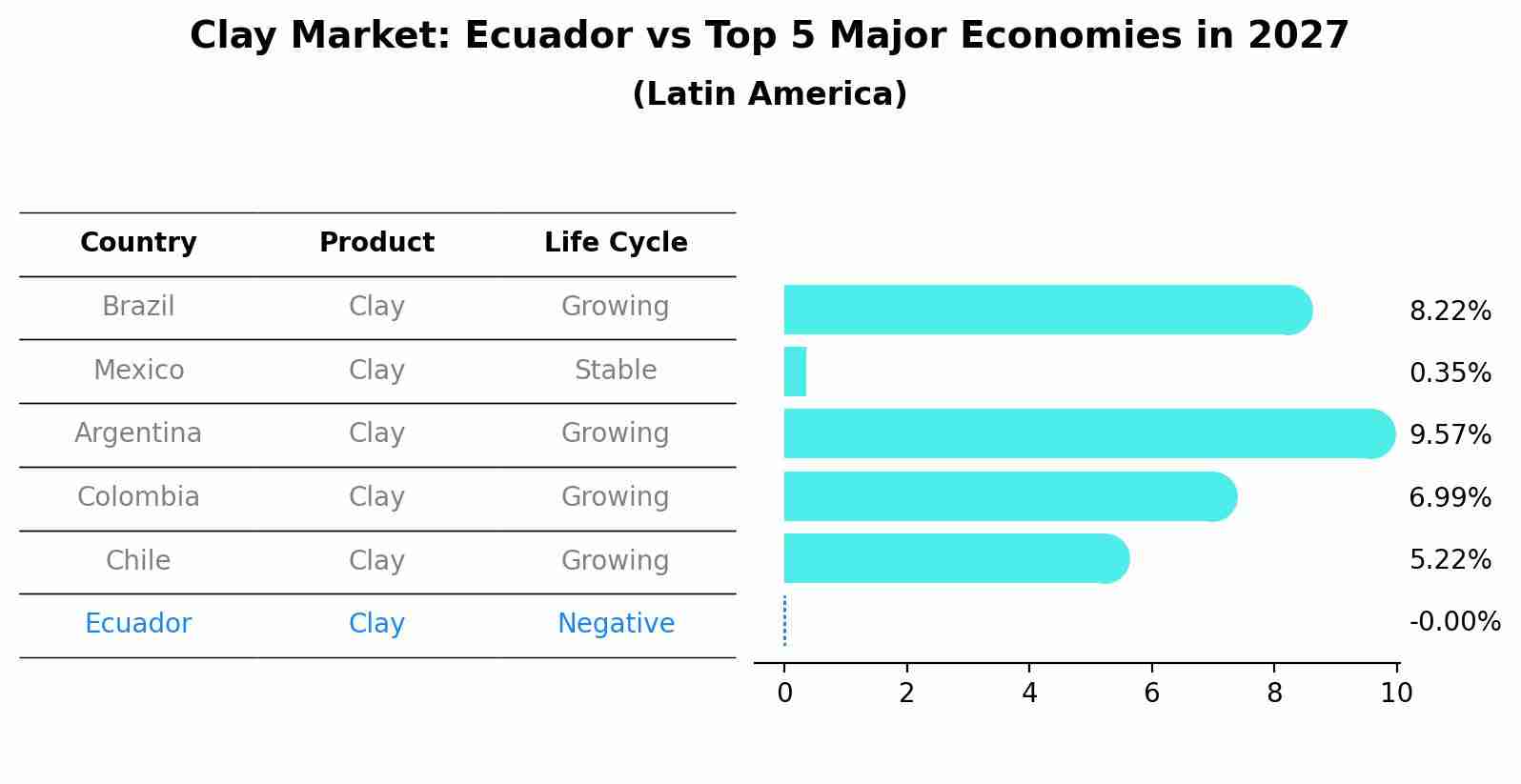Ecuador Clay Market (2025-2031) | Share, Forecast, Growth, Companies, Outlook, Value, Analysis, Trends, Size, Industry, Segmentation & Revenue
| Product Code: ETC5257651 | Publication Date: Nov 2023 | Updated Date: Oct 2025 | Product Type: Market Research Report | |
| Publisher: 6Wresearch | Author: Bhawna Singh | No. of Pages: 60 | No. of Figures: 30 | No. of Tables: 5 |
Ecuador Clay Market Top 5 Importing Countries and Market Competition (HHI) Analysis
Ecuador`s clay import Market Top 5 Importing Countries and Market Competition (HHI) Analysis in 2024 saw significant contributions from the USA, UK, Colombia, China, and Mexico. The high Herfindahl-Hirschman Index (HHI) concentration indicates a competitive landscape. With a strong compound annual growth rate (CAGR) of 15.23% from 2020 to 2024, the Market Top 5 Importing Countries and Market Competition (HHI) Analysis exhibited robust expansion. Although the growth rate slightly slowed to 1.77% from 2023 to 2024, the overall trend remains positive, showcasing continued opportunities for importers and stakeholders in the Ecuadorian clay Market Top 5 Importing Countries and Market Competition (HHI) Analysis.

Clay Market: Ecuador vs Top 5 Major Economies in 2027 (Latin America)
The Clay market in Ecuador is projected to grow at a negative growth rate of -0.00% by 2027, within the Latin America region led by Brazil, along with other countries like Mexico, Argentina, Colombia and Chile, collectively shaping a dynamic and evolving market environment driven by innovation and increasing adoption of emerging technologies.

Ecuador Clay Market Overview
The clay market in Ecuador is expanding due to the growing demand for clay in construction, pottery, and art applications. Clay is a versatile material used in various industries, from traditional pottery to advanced construction materials. The rising interest in artisanal crafts and sustainable building practices is driving the growth of the clay market. Additionally, the increasing availability of various clay types, including earthenware and stoneware, is enhancing the market`s appeal to consumers and manufacturers alike.
Drivers of the market
The clay market in Ecuador is influenced by the rising demand for clay in various applications, including ceramics, construction, and agriculture. As industries seek sustainable and versatile raw materials, the adoption of clay is growing. Additionally, the increasing interest in eco-friendly building materials and the resurgence of traditional crafts are driving market dynamics, promoting the use of clay in art and construction.
Challenges of the market
The clay market in Ecuador is constrained by competition from synthetic alternatives and fluctuating demand across various industries, such as construction and ceramics. Many manufacturers are also facing challenges related to the sourcing of high-quality raw materials, which can impact product consistency and pricing. Additionally, a lack of innovation in clay products limits the ability of local producers to differentiate themselves in the market.
Government Policy of the market
Ecuador supports the clay market through policies that encourage sustainable extraction and processing. The government offers tax benefits to companies adhering to environmental regulations, aiming to promote sustainable practices in construction and ceramics industries that rely on clay as a raw material.
Key Highlights of the Report:
- Ecuador Clay Market Outlook
- Market Size of Ecuador Clay Market, 2024
- Forecast of Ecuador Clay Market, 2031
- Historical Data and Forecast of Ecuador Clay Revenues & Volume for the Period 2021-2031
- Ecuador Clay Market Trend Evolution
- Ecuador Clay Market Drivers and Challenges
- Ecuador Clay Price Trends
- Ecuador Clay Porter`s Five Forces
- Ecuador Clay Industry Life Cycle
- Historical Data and Forecast of Ecuador Clay Market Revenues & Volume By Application for the Period 2021-2031
- Historical Data and Forecast of Ecuador Clay Market Revenues & Volume By Tableware for the Period 2021-2031
- Historical Data and Forecast of Ecuador Clay Market Revenues & Volume By Sanitary ware for the Period 2021-2031
- Historical Data and Forecast of Ecuador Clay Market Revenues & Volume By Medical applications for the Period 2021-2031
- Historical Data and Forecast of Ecuador Clay Market Revenues & Volume By End Use for the Period 2021-2031
- Historical Data and Forecast of Ecuador Clay Market Revenues & Volume By Ceramic and for the Period 2021-2031
- Historical Data and Forecast of Ecuador Clay Market Revenues & Volume By Non-ceramic for the Period 2021-2031
- Ecuador Clay Import Export Trade Statistics
- Market Opportunity Assessment By Application
- Market Opportunity Assessment By End Use
- Ecuador Clay Top Companies Market Share
- Ecuador Clay Competitive Benchmarking By Technical and Operational Parameters
- Ecuador Clay Company Profiles
- Ecuador Clay Key Strategic Recommendations
Frequently Asked Questions About the Market Study (FAQs):
1 Executive Summary |
2 Introduction |
2.1 Key Highlights of the Report |
2.2 Report Description |
2.3 Market Scope & Segmentation |
2.4 Research Methodology |
2.5 Assumptions |
3 Ecuador Clay Market Overview |
3.1 Ecuador Country Macro Economic Indicators |
3.2 Ecuador Clay Market Revenues & Volume, 2021 & 2031F |
3.3 Ecuador Clay Market - Industry Life Cycle |
3.4 Ecuador Clay Market - Porter's Five Forces |
3.5 Ecuador Clay Market Revenues & Volume Share, By Application, 2021 & 2031F |
3.6 Ecuador Clay Market Revenues & Volume Share, By End Use, 2021 & 2031F |
4 Ecuador Clay Market Dynamics |
4.1 Impact Analysis |
4.2 Market Drivers |
4.2.1 Growing demand for eco-friendly and sustainable building materials |
4.2.2 Increasing adoption of clay products in construction and infrastructure projects |
4.2.3 Favorable government regulations promoting the use of natural materials like clay in construction |
4.3 Market Restraints |
4.3.1 Fluctuations in raw material prices impacting production costs |
4.3.2 Intense competition from alternative building materials such as concrete and steel |
5 Ecuador Clay Market Trends |
6 Ecuador Clay Market Segmentations |
6.1 Ecuador Clay Market, By Application |
6.1.1 Overview and Analysis |
6.1.2 Ecuador Clay Market Revenues & Volume, By Tableware, 2021-2031F |
6.1.3 Ecuador Clay Market Revenues & Volume, By Sanitary ware, 2021-2031F |
6.1.4 Ecuador Clay Market Revenues & Volume, By Medical applications, 2021-2031F |
6.2 Ecuador Clay Market, By End Use |
6.2.1 Overview and Analysis |
6.2.2 Ecuador Clay Market Revenues & Volume, By Ceramic and, 2021-2031F |
6.2.3 Ecuador Clay Market Revenues & Volume, By Non-ceramic, 2021-2031F |
7 Ecuador Clay Market Import-Export Trade Statistics |
7.1 Ecuador Clay Market Export to Major Countries |
7.2 Ecuador Clay Market Imports from Major Countries |
8 Ecuador Clay Market Key Performance Indicators |
8.1 Percentage of construction projects utilizing clay products |
8.2 Number of eco-friendly certifications obtained by clay product manufacturers |
8.3 Research and development investment in enhancing clay product properties and applications |
9 Ecuador Clay Market - Opportunity Assessment |
9.1 Ecuador Clay Market Opportunity Assessment, By Application, 2021 & 2031F |
9.2 Ecuador Clay Market Opportunity Assessment, By End Use, 2021 & 2031F |
10 Ecuador Clay Market - Competitive Landscape |
10.1 Ecuador Clay Market Revenue Share, By Companies, 2024 |
10.2 Ecuador Clay Market Competitive Benchmarking, By Operating and Technical Parameters |
11 Company Profiles |
12 Recommendations | 13 Disclaimer |
- Single User License$ 1,995
- Department License$ 2,400
- Site License$ 3,120
- Global License$ 3,795
Search
Related Reports
- ASEAN and Thailand Brain Health Supplements Market (2025-2031) | Strategy, Consumer Insights, Analysis, Investment Trends, Opportunities, Growth, Size, Share, Industry, Revenue, Segments, Value, Segmentation, Supply, Forecast, Restraints, Outlook, Competition, Drivers, Trends, Demand, Pricing Analysis, Competitive, Strategic Insights, Companies, Challenges
- ASEAN Bearings Market (2025-2031) | Strategy, Consumer Insights, Analysis, Investment Trends, Opportunities, Growth, Size, Share, Industry, Revenue, Segments, Value, Segmentation, Supply, Forecast, Restraints, Outlook, Competition, Drivers, Trends, Demand, Pricing Analysis, Competitive, Strategic Insights, Companies, Challenges
- Europe Flooring Market (2025-2031) | Outlook, Share, Industry, Trends, Forecast, Companies, Revenue, Size, Analysis, Growth & Value
- Saudi Arabia Manlift Market (2025-2031) | Outlook, Size, Growth, Trends, Companies, Industry, Revenue, Value, Share, Forecast & Analysis
- Uganda Excavator, Crane, and Wheel Loaders Market (2025-2031) | Strategy, Consumer Insights, Analysis, Investment Trends, Opportunities, Growth, Size, Share, Industry, Revenue, Segments, Value, Segmentation, Supply, Forecast, Restraints, Outlook, Competition, Drivers, Trends, Demand, Pricing Analysis, Competitive, Strategic Insights, Companies, Challenges
- Rwanda Excavator, Crane, and Wheel Loaders Market (2025-2031) | Strategy, Consumer Insights, Analysis, Investment Trends, Opportunities, Growth, Size, Share, Industry, Revenue, Segments, Value, Segmentation, Supply, Forecast, Restraints, Outlook, Competition, Drivers, Trends, Demand, Pricing Analysis, Competitive, Strategic Insights, Companies, Challenges
- Kenya Excavator, Crane, and Wheel Loaders Market (2025-2031) | Strategy, Consumer Insights, Analysis, Investment Trends, Opportunities, Growth, Size, Share, Industry, Revenue, Segments, Value, Segmentation, Supply, Forecast, Restraints, Outlook, Competition, Drivers, Trends, Demand, Pricing Analysis, Competitive, Strategic Insights, Companies, Challenges
- Angola Excavator, Crane, and Wheel Loaders Market (2025-2031) | Strategy, Consumer Insights, Analysis, Investment Trends, Opportunities, Growth, Size, Share, Industry, Revenue, Segments, Value, Segmentation, Supply, Forecast, Restraints, Outlook, Competition, Drivers, Trends, Demand, Pricing Analysis, Competitive, Strategic Insights, Companies, Challenges
- Israel Intelligent Transport System Market (2025-2031) | Strategy, Consumer Insights, Analysis, Investment Trends, Opportunities, Growth, Size, Share, Industry, Revenue, Segments, Value, Segmentation, Supply, Forecast, Restraints, Outlook, Competition, Drivers, Trends, Demand, Pricing Analysis, Competitive, Strategic Insights, Companies, Challenges
- Uganda Precast and Aggregate Market (2025-2031) | Strategy, Consumer Insights, Analysis, Investment Trends, Opportunities, Growth, Size, Share, Industry, Revenue, Segments, Value, Segmentation, Supply, Forecast, Restraints, Outlook, Competition, Drivers, Trends, Demand, Pricing Analysis, Competitive, Strategic Insights, Companies, Challenges
Industry Events and Analyst Meet
Our Clients
Whitepaper
- Middle East & Africa Commercial Security Market Click here to view more.
- Middle East & Africa Fire Safety Systems & Equipment Market Click here to view more.
- GCC Drone Market Click here to view more.
- Middle East Lighting Fixture Market Click here to view more.
- GCC Physical & Perimeter Security Market Click here to view more.
6WResearch In News
- Doha a strategic location for EV manufacturing hub: IPA Qatar
- Demand for luxury TVs surging in the GCC, says Samsung
- Empowering Growth: The Thriving Journey of Bangladesh’s Cable Industry
- Demand for luxury TVs surging in the GCC, says Samsung
- Video call with a traditional healer? Once unthinkable, it’s now common in South Africa
- Intelligent Buildings To Smooth GCC’s Path To Net Zero













